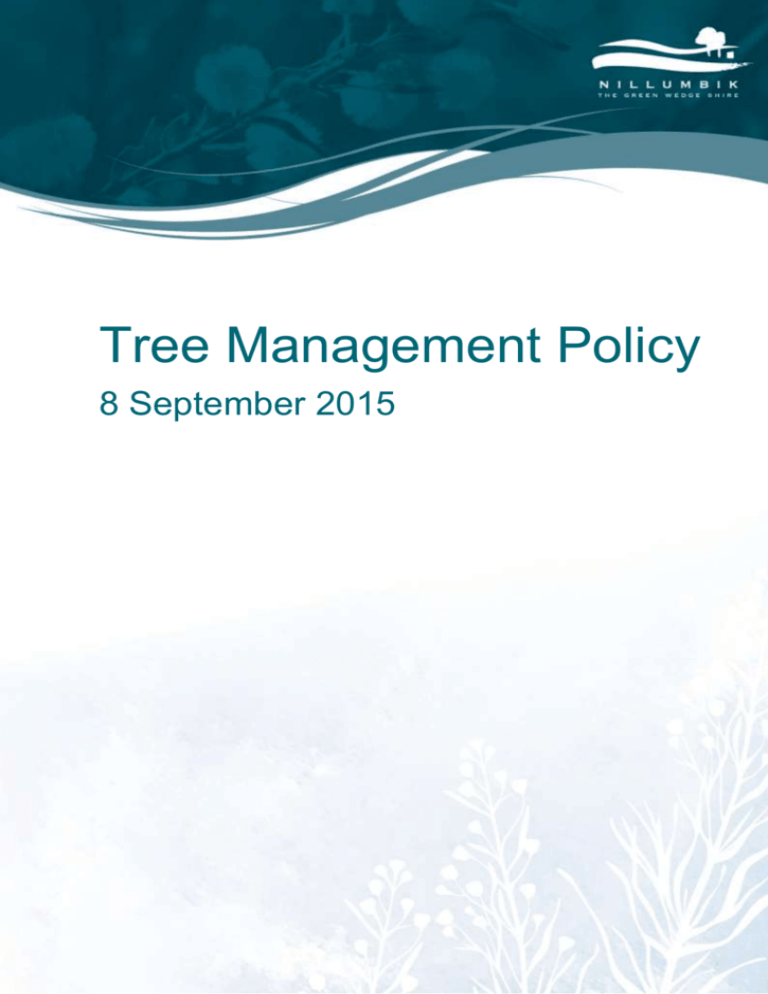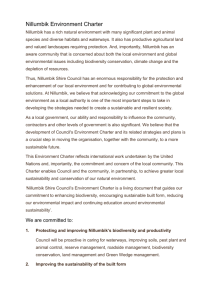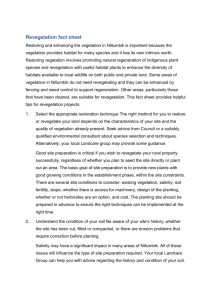Nillumbik Tree Management Policy 2015
advertisement

Tree Management Policy 8 September 2015 1 Tree Management Policy 2015 Contents Tree Management Policy Summary ...................................................................................... 3 1. 2. Introduction .................................................................................................................... 3 1.1. Purpose .................................................................................................................. 4 1.2. Scope ..................................................................................................................... 4 1.3. Objectives ............................................................................................................... 4 1.4. Responsibilities and commitments .......................................................................... 4 1.5. Risk Management ................................................................................................... 6 Policy ............................................................................................................................. 6 2.1. Community consultation .......................................................................................... 6 2.2. Tree Maintenance ................................................................................................... 6 2.3. Tree removal........................................................................................................... 7 2.4. Tree Planting .......................................................................................................... 7 2.5. Exceptional circumstances...................................................................................... 8 2 Tree Management Policy Summary Trees are a vital part of Nillumbik’s urban and rural areas, underpinning the character of the Shire and its natural ecosystems. Nillumbik Shire Council is committed to conserving trees within its areas of responsibility. It will achieve this through new tree plantings and managing existing trees on Council managed roadsides, reserves and properties. Council commits to delivering proactive tree maintenance works programs to meet the Electric Line Clearance Plan and assist in meeting the objectives of the Municipal Emergency Management Plan and Municipal Fire Management Plan. Council will respond to reported tree issues to manage the risk posed by trees to people and property. Council also has tree planting programs based on community and environmental need. For the purpose of this policy and associated guidelines, a tree is defined as a long lived woody perennial plant greater than (or usually greater than) 3 m in height with one or relatively few main stems or trunks (Australian Standard 4373:2015). The Policy outlines our commitment to managing and caring for trees in line with public safety, conservation and tree health. The Nillumbik Tree Management Guidelines specify how Council will implement this policy. The nature of works may change in response to environmental conditions, community priorities, government policy and best practice management. Council will keep residents informed about works that directly affect them and consult the community in regards to any major change in policy. Council will deliver works to comply with all federal, state and local legislative requirements. 1. Introduction Nillumbik Shire has a rich and diverse natural environment. Its leafy urban areas support many remnant and planted native trees and native bushland covers much of its rural landscapes. Council and the community value a balance with nature. They seek to protect, nurture and experience the environment so that it can sustain life. (Council Plan 2013-17) The Neighbourhood Character Study (2000) found that the character of the Shire is heavily dependent upon its native vegetation and significant trees, often more than the form of buildings. As well as defining character, trees are vital for their contribution to biodiversity and ecosystem services (air quality, water quality, climate stabilisation, soil health and shade) and amenity value for people. Trees have a natural process of growing, ageing and dying. Drought, bushfire, climate change and urban development also impact the health and number of trees. Over time, this can result in loss of tree cover and pose potential risks to people and property in populated areas (falling limbs, growing tree roots, etc.). The challenge for Council is to conserve biodiversity and the natural character of Nillumbik while managing these risks. It is estimated that Council is responsible for around 500,000 trees on reserves, roadsides and other council owned or managed properties. This includes 800km of Council managed 3 roads, the non-trafficable area of VicRoads roads within 60km or less zones and around 750 properties including 850ha of reserves. As well as planting trees, Council manages existing trees in relation to hazards they pose to people and property, road infrastructure, electric and telecommunication lines, fire and cultural significance. Council’s total tree management budget for 2014-15 was $1.33 million. This includes the annual capital expenditure budget for Street Tree Planting ($77,000 2014/15, $79,000 2015/16). As Council is responsible for so many trees, across such a large area it is not possible to inspect all trees for hazards. Based on the estimated number of trees, if Council was to inspect every tree it would cost more than $36.39 million, even without doing the resulting maintenance works. To minimise the risk to people and property within the available budget, Council delivers a program of proactive and reactive works according to risk management principles. 1.1. Purpose This tree management policy sets an agreed standard of service for tree planting and management. Having an agreed policy means that when issues arise there is a clear framework to guide Council’s actions and provide the community with a consistent and agreed standard of service. 1.2. Scope The scope of this policy covers the planting and maintenance of all trees on all Council owned or managed land. Council has responsibilities for managing trees on the following land classes: Reserves and properties that Council owns and/or manages Council managed roadsides VicRoads roads within 60km or less zones and/or VicRoads roads as defined in a maintenance agreement between Council and VicRoads. 1.3. Objectives The key objectives of this policy are to: Maintain and enhance Nillumbik’s tree population on Council owned and managed land to maximise benefits to the environment and the community, contributing to a gain in quality and quantity of native vegetation across the Shire Meet all relevant legislative requirements and apply consistent management practices Minimise and manage risks to the community within Council’s legal responsibilities and capacity to deliver tree services as far as reasonably practical. Engage the community in the management, restoration and enhancement of Nillumbik’s urban and rural environment 1.4. Responsibilities and commitments On Council owned and managed land, Council has statutory or accepted management responsibilities to: 4 manage trees and tree roots that pose a hazard to people or property clear around roads, footpaths, and street signs where encroaching vegetation may cause a significant hazard maintain clearance around electric lines in declared areas manage trees causing disruptions to telecommunication services preserve native vegetation and other trees covered by a significant landscape overlay or listed under the heritage overlay of the planning scheme prevent injury to animals living in trees and where possible protect habitat for these species plant trees in nature strips and reserves in the Shire to maintain and enhance Nillumbik’s tree population. Tree management practices are guided by the following policies, plans and procedures: Nillumbik Tree Management Guidelines 2015 Council Plan 2013-2017 – Council has made commitments to: o ‘preserve and nurture the natural environment of the Green Wedge for future and current generations through responsible leadership and stewardship’ o ‘strive for a clean, well-maintained Shire that enhances a sense of community pride and safety’ o ‘plan so that any development is sympathetic to the Shire’s unique heritage and protects neighbourhood character and our tree canopy’ Electric Line Clearance Regulations Nillumbik Electric Line Clearance Plan Municipal Emergency Management Plan Municipal Fire Management Plan Nillumbik Shire Council Road Management Plan 2013 Nillumbik Shire Council Roadside Management Plan 2012 Nillumbik Shire Council Biodiversity Strategy 2012 Residential Design Guidelines as part of the implementation of the Shire of Nillumbik Neighbourhood Character Study 2000 Nillumbik Neighbourhood Character Policy Nillumbik Environment Charter 2013 Nillumbik Climate Change Action Plan 2010 Australian Standard/ New Zealand Standard 31000-2009 Risk Management Australian Standard 4373-2007 Pruning of amenity trees Australian Standard 2303:2015 Tree stock for landscape use VicRoads Design Guidelines Victoria’s Native vegetation permitted clearing regulations 2013 Managing native vegetation on roadsides: A guideline for implementing agreements under the local government public road exemption 2009 Planning and Environment Act 1987 Nillumbik Planning Scheme Flora and Fauna Guarantee Act 1988 Prevention of Cruelty to Animals Act 1986 Environment Protection and Biodiversity Conservation Act 1999 (Federal) Nillumbik Shire Council Amenity Local Law 5 Nillumbik Over-the-counter Offset Program – Native Vegetation 2015 (draft) Nillumbik Shire Council Bushland Reserves Prioritisation and Planning Guidelines Nillumbik Invasive Species Action Plan Nillumbik Climate Change Action Plan 1.5. Risk Management An important consideration for Council is the management of risk of injury or property damage caused by trees. Public health, safety and general welfare will be maintained through the application of the Australian Standard/New Zealand Standard AS/NZS 31000:2009 and use of accepted practices for the evaluation and treatment to reduce risks to people and property from tree hazards. To manage risks associated with trees Council will: deliver a reactive tree maintenance program (including tree roots) to assess and manage reported tree risks deliver proactive tree maintenance programs for the purpose of: o Electric line clearance in designated areas o meeting the objectives of the Municipal Emergency Management Plan and Municipal Fire Management Plan provide a guide for residents planting trees on nature strips undertake proper selection, placement and planting of trees in accordance with this policy to reduce long-term risk The Nillumbik Tree Management Guidelines provides a risk based decision-making guide that Council can use to consider running additional proactive tree maintenance programs. 2. Policy 2.1. Council will provide clear messages to the community about the tree services provided by Council. Council will provide simple mechanisms for the community to request tree works and keep them informed at each stage of service delivery. Where practicable, Council will inform affected residents about tree works in their local area. Council will consult the community about major works and changes in policy. Within bushland reserves and wetlands, Council will encourage community participation in tree planting. 2.2. Community consultation Tree Maintenance Tree maintenance works include pruning to reduce the risk to public safety; decrease potential property damage; provide clearances for pedestrians, vehicles and around electric and telecommunication lines; provide lines of sight along roads and around traffic signs; maintain tree health; and shape young trees to promote structurallysound branching for the future. Furthermore, trees are pruned in response to 6 unexpected events or emergencies, such as tree or branch failure resulting from severe storms. Tree maintenance may also include pest and disease treatment and control of regrowth into clearance spaces. Where practicable, Council will deliver works that minimise the impact on biodiversity. Council will deliver an annual works program to assist in meeting the objectives of the Municipal Emergency Management Plan and Municipal Fire Management Plan. These plans are developed by the Municipal Emergency Management Planning Committee and Municipal Fire Management Planning Committee. The committees use a risk based strategy to determine where and how risk treatments should be applied which includes management of hazardous trees. Council will prepare an Electric Line Clearance Management Plan by March 31 each year. Council will seek to complete the electric line clearance specified in the plan prior to the start of the declared fire season in accordance with the code. Although the code requires Council to maintain the required clearances at all times, completion of works prior to the fire season will ensure that the fire risk is minimised. Council will respond to requests for other tree maintenance works at it’s discretion to restore tree health and reduce the inherent risks associated with trees in populated areas. Council may decide to carry out additional tree maintenance programs prioritised based on resource availability and the risk to the community. 2.3. Council will avoid tree removal wherever possible. Council may consider tree removal when a tree poses undue risk to people or property, to facilitate approved development and infrastructure improvements, to maintain a healthy urban forest or for ecological restoration. Where practicable, Council will deliver works that minimise the impact on biodiversity. Council will keep a list of all trees removed and plant replacements if appropriate. Council will meet the requirements of the Nillumbik Planning Scheme, which may require indigenous vegetation planting on public and private land in response to vegetation removal. 2.4. Tree removal Tree Planting Council will plant predominantly indigenous species. Other native and exotic species may be used where considered appropriate. Council plants advanced trees in urban nature strips and traffic features (e.g. roundabouts, medians, kerb outstands) according to the considerations outlined in the Tree Management Guidelines. Council will plant trees and other species within recreation reserves and on other Council properties including road reserves for community and environmental benefit. The quality of the planting stock is a vital factor contributing to the longevity of the tree in the ground. Council should be sourcing planting stock that meets the Australian Standard 2303:2015 Tree stock for landscape use, and require this standard of developers when planting trees in new developments. Within bushland areas (reserves, wetlands and roadsides), Council will plant indigenous species to restore diversity and structure, buffer and connect native vegetation and provide habitat for threated species. Council will also support 7 indigenous revegetation and supplementary planting in Council bushland reserves and on private land through ‘Friends of’ Groups, Landcare and the Council incentive programs in accordance with the Nillumbik Bushland Reserves Prioritisation and Planning Guidelines. Street tree planting is a condition of new sub division development within the Shire: o As part of an application for a subdivision that creates streets or public open space, developers must submit a landscape design as outlined in Provision 56.05 Urban Landscape of the Nillumbik Planning Scheme. This includes implementing any relevant streetscape, landscape, urban design or native vegetation precinct plan, strategy or policy for the area set out in the scheme o Council officers with responsibilities for managing open space, landscape design and bushland reserves as required will approve the landscape design and species selected in accordance with the Nillumbik Tree Management Guidelines o When the developer organises the planting they must meet Council’s minimum requirements as specified in the Nillumbik Tree Management Guidelines If a resident wishes to plant trees or other vegetation on Council land (e.g. nature strips, roadsides and reserves), they must seek written permission from Council before doing so. This includes planting for amenity, environmental and memorial purposes. The resident can only use plants listed in the Council publication ‘Live Local Plant Local’ or follow the species selection in accordance with the Nillumbik Tree Management Guidelines. Nillumbik’s Amenity Local Law (2013) Part 4 states that ‘Without a permit a person must not on any Council land plant trees or vegetation.’ Council may remove such plantings at their discretion and no compensation will be available to residents for the removal of these plants. Planting will be done with consideration of the impact on existing bushfire mitigation treatments including designated Neighbourhood Safer Places- Places of Last resort. Tree planting will be in locations appropriate to the species and undertaken at seasonally appropriate times. 2.5. Exceptional circumstances Council will make every effort to meet its commitments under this policy and associated guidelines. However, there may be situations or circumstances that affect Council's business activities to the extent that it cannot deliver on the service levels of the Nillumbik Tree Management Policy and Guidelines. These include but are not limited to natural disasters (such as fires, floods, or storms), a prolonged labour or resource shortage, or a need to commit or redeploy Council staff and/or equipment elsewhere. In the event that Council’s General Manager of Infrastructure Services has considered the impact of such an event on the limited financial resources of Council and its other conflicting priorities, and determined that the programs and timeframes covered by the Tree Management Policy and guidelines cannot be met, then pursuant to Section 83 of the Wrongs Act, the General Manager of Infrastructure Services will approve the suspension of the Tree Management Policy and associated guidelines. 8 Once the scope of the event/s have been determined, and resources committed to the event response have been identified, then there will be an ongoing consultation between General Manager of Infrastructure Services and Infrastructure Maintenance Manager for the Tree Management Policy, to determine which parts of the Tree Management Policy are to be reactivated and when. Council statements to residents about the suspension or reduction of the services under the Tree Management Policy will include reference to how the work that will be done has been prioritised, and the period for which it is likely to be affected. Details of the incident that led to the "Exceptional Circumstances" clause being activated, and then the process taken to re-enact the Tree Management Policy, should be recorded and stored. 9









